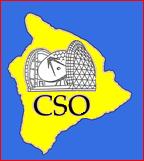A BRIEF HISTORY OF THE CALTECH SUBMILLILMETER OBSERVATORY
Walter R. Steiger
|

| |
|
"The submillimeter portion of the spectrum yields the best probes of the
physical and chemical conditions in molecular clouds, and may finally permit us
to observe how an interstellar cloud actually collapses to form a protostar."
INTRODUCTION
he development of infrared astronomy was a new and active discipline in the mid-1960s. The development of infrared detectors was the key to progress in this field. One of the active centers of this work was at Caltech where Dr. Gerry Neugebauer was a leader of the program. Neugebauer had joined with Dr. Robert Leighton to develop a small telescope to make the now famous 2 micron survey of the sky. After that was finished, Leighton turned his attention to devising methods for making larger (~ 10m) telescopes for millimeter and submillimeter wavelengths. This new field was only slowly developing, due to the lack of established detectors and the strong water vapor and oxygen absorption by the Earth's atmosphere. Nevertheless, it was a field of great interest, holding the key to star formation and the physics and the chemistry of the interstellar medium (ISM). Leighton, Neugebauer, and Al Moffet, a Caltech professor of radio astronomy, applied to the NSF for a grant to build a three-telescope mm-wavelength interferometer for use at the Owens Valley Radio Observatory (OVRO) site, and a single telescope for submillimeter work at a suitable high-altitude site. The Owens Valley site was not suitable for submm work due to the strong absorption by water vapor in the Earth's atmosphere. To gain access to the submm region one must find a site that is well above a large percentage of the water vapor in the atmosphere. Early on it was recognized that Mauna Kea in Hawaii, at almost 14,000 feet elevation, would be such a site. And so, a fourth 10.4-meter super-dish was proposed to produce diffraction-limited images in the submm range. The NSF made a grant for the first three telescopes but held off on the fourth telescope until the interferometer was completed. Under the direction of Moffet, the interferometer development went slowly but Leighton proceeded to work on the fourth telescope, for which he had taken on Thomas G. Phillips for the development of the submm telescope. At this point the NSF declined further funding until the interferometer was completed, and so, even though Phillips was the director-designate of the submm telescope, he was asked to take over the completion of the interferometer. Thus, Phillips spent the next four years seeing to the interferometer at Owens Valley, while at the same time accomplishing some of the background jobs in preparation for the super submm telescope. He had the foresight to begin the Environmental Impact study for a Mauna Kea site as early as 1980 and this was completed in 1983. During this time he also examined the question of an optimal site on the mountain for submm work in terms of total column water vapor. It had been suggested that sites below the summit in a basin or sort of valley might be inferior, but his systematic measurements with a hand-held instrument showed that, on the average, a site in the basin, some 300 feet below the summit, was just as good as on the summit. This greatly simplified the choice of a site, and subsequently other submm facilities have been located nearby and the area is now designated as the "Submillimeter Valley". In the mean time, additional funding for the submm telescope was obtained from other sources and when the OVRO interferometer was completed, Phillips took on full-time the directorship of the super submm telescope.Placing a telescope on Mauna Kea involved a number of new challenges. The telescope would require a dome, not only to house and protect the telescope but also provide space for the control room, laboratories, and other amenities required at a remote site. As for the construction of the dome, it was decided that, as it was a totally novel design, it would be optimal to build everything right on the Caltech campus in Pasadena in such a way that it could be dismantled and shipped to Hawaii for reassembly. As for the telescope itself, the back-up structure of the dish was designed and built on the campus and shipped in parts to Hawaii, along with the alt-azimuth support structure. The telescope was assembled and tested for the first time on site at Mauna Kea. Designing the dome began around 1981 and construction in Pasadena on the Caltech football field began in 1984. After dismantling, shipping to Hawaii, and reassemby, the installation was basically complete in 1987, although the formal dedication took place on November 22, 1986. First light, with an image of M82, took place on March 15, 1987. Development of the Mauna Kea observatory proceded, more-or-less simultaneously, in three separate phases. The first and perhaps most critical was the development of detectors of submm radiation; the second and also extremely critical was the design and construction of a 10.4-m dish that would provide a highly accurate parabolic surface and be free of distortion from changes in position; and finally, a dome to house the telescope. Because of his background in superconductors and low-temperature physics, Tom Phillips was the receiver expert. Bob Leighton was the designer of the dish and the dome. The team also included engineers Walt Schaal and Dave Vail, and graduate student Ken "Taco" Young.The initial funding for CSO of $3.9 million came from the National Science Foundation, and the Foundation continues to support its operations. Funds were also provided by the Kresge Foundation of Troy, Michigan; Francis L. Moseley of Flintridge, California; Prince Charitable Trust of Chicago; and NASA. |
||